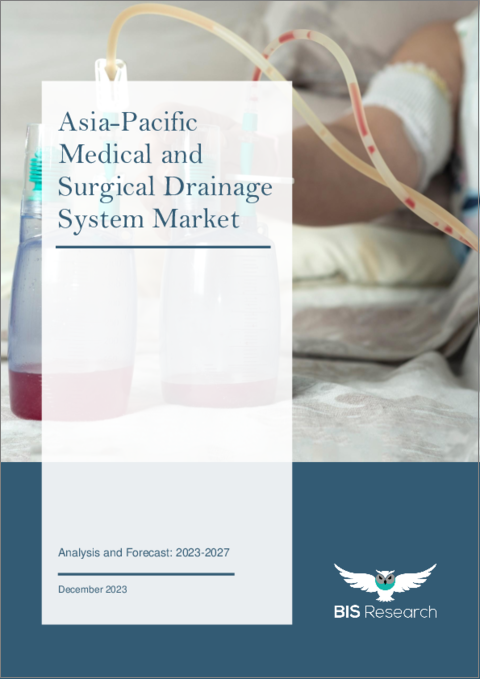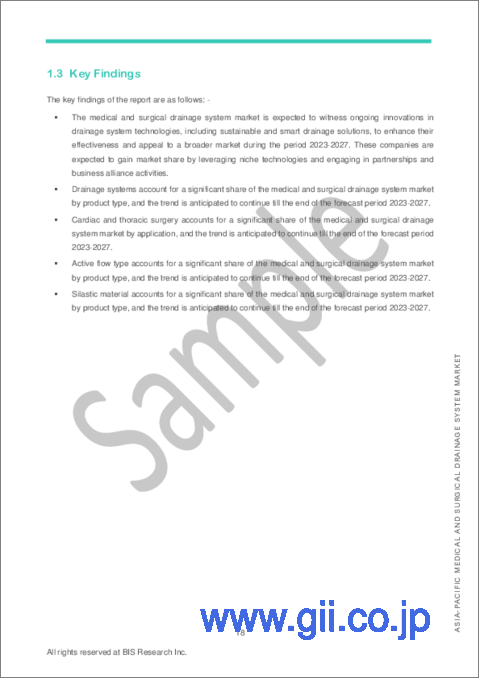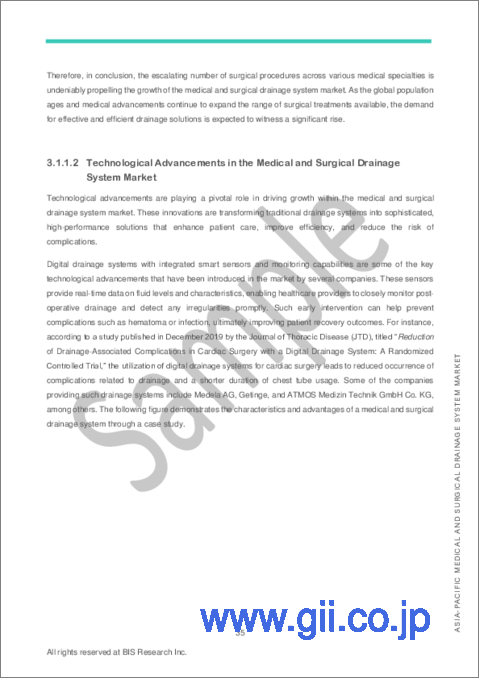|
|
市場調査レポート
商品コード
1399759
アジア太平洋の医療・外科用ドレナージシステム市場:分析と予測(2023年~2027年)Asia-Pacific Medical and Surgical Drainage System Market - Analysis and Forecast, 2023-2027 |
||||||
カスタマイズ可能
|
|||||||
| アジア太平洋の医療・外科用ドレナージシステム市場:分析と予測(2023年~2027年) |
|
出版日: 2023年12月28日
発行: BIS Research
ページ情報: 英文 87 Pages
納期: 1~5営業日
|
全表示
- 概要
- 図表
- 目次
アジア太平洋の医療・外科用ドレナージシステムの市場規模は、2023年~2027年の予測期間中に5.69%のCAGRで拡大し、2022年の2億5,100万米ドルから2027年には3億2,510万米ドルに達すると予測されています。
世界の手術件数の増加、医療・外科用ドレナージシステム産業における技術進歩、高齢者人口の増加が、アジア太平洋医療・外科用ドレナージシステム市場の成長を促進する主な要因です。
| 主要市場統計 | |
|---|---|
| 予測期間 | 2023年~2027年 |
| 2023年評価 | 2億6,050万米ドル |
| 2027年予測 | 3億2,510万米ドル |
| CAGR | 5.69% |
ドレナージシステムは、手術部位や切開部から血液などの過剰な体液を体外に排出する医療機器です。このような装置は通常、外科医が外科手術中に採用し、回復を妨げ、感染症や血腫形成などの合併症につながる可能性のある体液貯留の防止を支援します。外科用ドレナージシステムは、術後の体液貯留を調整し、創傷治癒を助けるために利用されます。
ドレナージシステムはヘルスケアにおいて重要な役割を担っており、体内からの液体や物質の除去を管理するために設計されたツールや方法を幅広く網羅しています。これらのシステムは医療現場において非常に重要であり、治癒を早め、合併症を予防し、患者の快適性を確保します。
当レポートでは、アジア太平洋の医療・外科用ドレナージシステム市場について調査し、市場の概要とともに、製品タイプ別、用途別、フロータイプ別、材料タイプ別、地域別の動向、および市場に参入する企業のプロファイルなどを提供しています。
目次
エグゼクティブサマリー
調査範囲
調査手法
第1章 市場
第2章 業界分析
- 概要
- 主要な動向
- 規制分析
- 米国
- 欧州
- 中国
- 日本
- 特許分析
- COVID-19の影響
- 製品のベンチマーク
第3章 市場力学
- 影響分析
第4章 地域
- 概要
- アジア太平洋の医療・外科用ドレナージシステム市場
- 中国の医療・外科用ドレナージシステム市場
- インドの医療・外科用ドレナージシステム市場
第5章 競合ベンチマーキングと企業プロファイル
- 競合ベンチマーキング
- 主要な戦略と展開
- 資金提供活動
- 合併と買収
- 製品の発売
- パートナーシップ、提携、事業拡大
- 規制および法的活動
- 世界の参入企業と中国の参入企業の分析
- 医療・外科用ドレナージシステム市場エコシステムにおける主要な参入企業
- 企業プロファイル
- Hangzhou Fushan Medical Appliances Co., LTD.
- Ningbo Luke Medical Co., LTD.
List of Figures
- Figure 1: Different Types of Drainage Systems
- Figure 2: Medical and Surgical Drainage System Market, $Million, 2021-2027
- Figure 3: Medical and Surgical Drainage System Market, Market Dynamics
- Figure 4: Medical and Surgical Drainage System Market (by Product Type), % Share, 2022 and 2027
- Figure 5: Medical and Surgical Drainage System Market (by Application), % Share, 2022 and 2027
- Figure 6: Medical and Surgical Drainage System Market (by Flow Type), % Share, 2022 and 2027
- Figure 7: Medical and Surgical Drainage System Market (by Material Type), % Share, 2022 and 2027
- Figure 8: Medical and Surgical Drainage System Market (by Region), $Million, 2022 and 2027
- Figure 9: Share of Key Developments, January 2020-August 2023
- Figure 10: Key Questions Answered in the Report
- Figure 11: Medical and Surgical Drainage System Market: Research Methodology
- Figure 12: Primary Research Methodology
- Figure 13: Bottom-Up Approach (Segment-Wise Analysis)
- Figure 14: Top-Down Approach (Segment-Wise Analysis)
- Figure 15: Medical and Surgical Drainage System Market, Size and Growth Potential, $Million, 2021-2027
- Figure 16: Advantages of Use of Biocompatible Material
- Figure 17: Medical and Surgical Drainage System Market, Patent Analysis (by Country), January 2020-August 2023
- Figure 18: Medical and Surgical Drainage System Market, Patent Analysis (by Year), January 2020-August 2023
- Figure 19: Impact of COVID-19 on Medical and Surgical Drainage System
- Figure 20: Medical and Surgical Drainage System Market, Product Benchmarking, By Application
- Figure 21: Medical and Surgical Drainage System Market, Impact Analysis
- Figure 22: Prevalence of Chronic Disorders, 2010 vs. 2019
- Figure 23: Surgical Volume Statistics and Need for Surgical Drainage
- Figure 24: Characteristics and Advantages of a Digital Drainage Systems: A Case Study
- Figure 25: Rising Geriatric Population, 2020, 2030 and 2050
- Figure 26: Medical and Surgical Drainage System Market, Incremental Opportunity (China and India), $Million, 2023-2027
- Figure 27: Medical and Surgical Drainage System Market (by Region), $Million, 2022 and 2027
- Figure 28: APAC Medical and Surgical Drainage System Market, $Million, 2021-2027
- Figure 29: APAC Medical and Surgical Drainage System Market (by Product Type), $Million, 2021-2027
- Figure 30: APAC Medical and Surgical Drainage System Market (by Drainage Type), $Million, 2021-2027
- Figure 31: APAC Medical and Surgical Drainage System Market (by Application), $Million, 2021-2027
- Figure 32: APAC Medical and Surgical Drainage System Market (by Flow Type), $Million, 2021-2027
- Figure 33: APAC Medical and Surgical Drainage System Market (by Material Type), $Million, 2021-2027
- Figure 34: China Medical and Surgical Drainage System Market, $Million, 2021-2027
- Figure 35: China Medical and Surgical Drainage System Market (by Product Type), $Million, 2021-2027
- Figure 36: China Medical and Surgical Drainage System Market (by Drainage Type), $Million, 2021-2027
- Figure 37: China Medical and Surgical Drainage System Market (by Application), $Million, 2021-2027
- Figure 38: China Medical and Surgical Drainage System Market (by Flow Type), $Million, 2021-2027
- Figure 39: China Medical and Surgical Drainage System Market (by Material Type), $Million, 2021-2027
- Figure 40: India Medical and Surgical Drainage System Market, $Million, 2021-2027
- Figure 41: India Medical and Surgical Drainage System Market (by Product Type), $Million, 2021-2027
- Figure 42: India Medical and Surgical Drainage System Market (by Drainage Type), $Million, 2021-2027
- Figure 43: India Medical and Surgical Drainage System Market (by Application), $Million, 2021-2027
- Figure 44: India Medical and Surgical Drainage System Market (by Flow Type), $Million, 2021-2027
- Figure 45: India Medical and Surgical Drainage System Market (by Material Type), $Million, 2021-2027
- Figure 46: Share of Key Developments, January 2020-August 2023
- Figure 47: Product Launches (by Company), January 2020-August 2023
- Figure 48: Partnerships, Alliances, and Business Expansions (by Company), January 2020-August 2023
- Figure 49: Hangzhou Fushan Medical Appliances Co., LTD.: Company Overview
- Figure 50: Ningbo Luke Medical Co., LTD.: Company Overview
List of Tables
- Table 1: Regulatory Framework
- Table 2: Regulatory Classification
- Table 3: Medical and Surgical Drainage System Market, Awaited Technological Developments
- Table 4: Global vs. Local Players
- Table 5: Medical and Surgical Drainage System Market, Ecosystem of Active Players
Introduction to APAC Medical and Surgical Drainage System Market
The APAC medical and surgical drainage system market is expected to reach $325.1 million by 2027 from $251.0 million in 2022, at a CAGR of 5.69% during the forecast period 2023-2027. The increase in surgery volume globally, technical advances in the medical and surgical drainage systems industry, and the rise in the geriatric population are the primary factors driving the growth of the APAC medical and surgical drainage systems market.
Market Introduction
| KEY MARKET STATISTICS | |
|---|---|
| Forecast Period | 2023 - 2027 |
| 2023 Evaluation | $260.5 Million |
| 2027 Forecast | $325.1 Million |
| CAGR | 5.69% |
Drainage systems are medical devices that remove excessive fluids from the body, such as blood from a surgical site or incision. These devices are typically employed by surgeons during surgical procedures to aid in the prevention of fluid collection, which can impair recovery and lead to complications such as infections or hematoma formation. Surgical drainage systems are utilized to regulate post-operative fluid collection and thereby aid in wound healing.
Market Segmentation:
Segmentation 1: by Product Type
- Drainage Systems
- Open
- Closed
- Accessories
Drainage Systems: Drainage systems play a vital role in healthcare, covering a wide range of tools and methods designed to manage the removal of fluids or substances from the body. These systems are incredibly important in medical settings, where they help speed up healing, prevent complications, and ensure patient comfort.
- Open: Open drains, which can be made from materials such as corrugated rubber or plastic sheets, serve as essential tools for draining fluids from specific areas, such as surgical sites or wounds.
- Closed: Closed drainage systems comprise tubes that direct fluids into a sealed bag or bottle. These systems are widely used in a range of medical contexts, including chest, abdominal, and orthopedic surgeries.
Accessories: In medical procedures involving drainage systems, several accessories are employed to ensure effective fluid management and patient well-being. These accessories encompass drainage bags for collecting fluids, flexible tubing for fluid transport, absorbent dressings to safeguard and direct fluids, clamps or connectors for fluid control, and skin barriers to protect the skin and maintain a secure seal.
Segmentation 2: by Application
- Cardiac and Thoracic Surgery
- Abdominal
- Orthopedic
- Others Surgeries
Cardiac and Thoracic Surgery: Cardiac and thoracic surgery is a specialized field of medicine that deals with procedures involving the heart and the chest area. After these surgeries, there's a standard post-operative practice where patients usually have pleural and/or mediastinal chest drains placed.
Abdominal: Abdominal drainage, also known as abdominal surgical drainage or abdominal wound drainage, is a medical procedure used to remove excess fluids, blood, or pus from the abdominal cavity following surgery or as a result of certain medical conditions. This drainage is crucial in preventing the accumulation of fluids, which can lead to complications such as infection, abscess formation, or impaired wound healing.
Orthopedic: Orthopedics is a medical field that specializes in taking care of your muscles, bones, and joints. Although drainage systems are more commonly associated with chest and abdominal surgeries, they are also relevant in orthopedic procedures, particularly those involving joint replacements.
Other Surgeries: The other surgeries include vascular procedures, neurosurgery, plastic surgery, and colorectal surgery, where drainage systems are commonly employed.
Segmentation 3: by Flow Type
- Active
- Passive
Active: Active drains are essential tools in surgical and medical care. These drains function with the aid of suction, which can be either low or high pressure, to effectively remove fluids.
Passive: Passive drainage systems are vital components in surgical procedures, relying on the natural pressure difference between the inside of the body and the external environment to facilitate the flow of fluids out of the body.
Segmentation 4: by Material Type
- Silastic
- Rubber
- Other Material
Silastic: Silastic drains, made from a biocompatible and inert material, cause minimal tissue reaction. These drains and medical devices are made from silicone rubber, a synthetic material known for its biocompatibility, flexibility, and inertness.
Rubber: Rubber drains, often referred to as surgical drains or drainage tubes, are medical devices used to remove fluids or air from the body following surgical procedures or in the treatment of certain medical conditions.
Other Material: The other material segment constitutes drains made up of materials such as polyvinyl chloride (PVC), polyurethane, and stainless steel, among others. PVC is a thermoplastic polymer that is used in surgical drains and is known for its flexibility and durability, making it suitable for various surgical applications.
Segmentation 5: by Region
- APAC
- China
- India
How Can This Report Add Value to an Organization?
Product/Innovation Strategy: The APAC medical and surgical drainage systems market has been extensively segmented based on various categories, such as products, applications, drainage types, material types, and flow types. This can help readers get a clear overview of the segments accounting for the largest share and the ones that are well-positioned to grow in the coming years.
Table of Contents
Executive Summary
Scope of the Report
Research Methodology
1. Markets
- 1.1. Product Definition
- 1.2. Inclusion and Exclusion
- 1.2.1. Inclusion Criteria
- 1.2.2. Exclusion Criteria
- 1.3. Key Findings
2. Industry Analysis
- 2.1. Overview
- 2.2. Key Trends
- 2.2.1. Introduction and Use of Smart Drains
- 2.2.2. Use of Novel Materials for the Development of Drainage System
- 2.3. Regulatory Analysis
- 2.3.1. U.S.
- 2.3.1.1. U.S. Food and Drugs Administration (U.S. FDA)
- 2.3.2. Europe
- 2.3.2.1. European Medicines Agency (EMA)
- 2.3.3. China
- 2.3.3.1. National Medical Products Administration (NMPA)
- 2.3.4. Japan
- 2.3.4.1. Pharmaceuticals and Medical Devices Agency (PMDA)
- 2.3.1. U.S.
- 2.4. Patent Analysis
- 2.4.1. Awaited Technological Developments
- 2.4.2. Patent Analysis (by Country)
- 2.4.3. Patent Analysis (by Year)
- 2.5. Impact of COVID-19
- 2.6. Product Benchmarking
3. Market Dynamics
- 3.1. Impact Analysis
- 3.1.1. Business Drivers
- 3.1.1.1. Increasing Surgical Volumes Globally
- 3.1.1.2. Technological Advancements in the Medical and Surgical Drainage System Market
- 3.1.1.3. Rising Geriatric Population
- 3.1.2. Business Restraints
- 3.1.2.1. Risk of Infections Associated with Drainage Systems
- 3.1.3. Business Opportunities
- 3.1.3.1. Increasing Opportunity in Emerging Economies
- 3.1.1. Business Drivers
4. Region
- 4.1. Overview
- 4.2. APAC Medical and Surgical Drainage System Market
- 4.2.1. Market Sizing and Forecast
- 4.2.1.1. APAC Medical and Surgical Drainage System Market, by Product Type
- 4.2.1.1.1. APAC Medical and Surgical Drainage System Market, by Drainage Type
- 4.2.1.2. APAC Medical and Surgical Drainage System Market, by Application
- 4.2.1.3. APAC Medical and Surgical Drainage System Market, by Flow Type
- 4.2.1.4. APAC Medical and Surgical Drainage System Market, by Material Type
- 4.2.1.1. APAC Medical and Surgical Drainage System Market, by Product Type
- 4.2.1. Market Sizing and Forecast
- 4.3. China Medical and Surgical Drainage System Market
- 4.3.1. Market Sizing and Forecast
- 4.3.1.1. China Medical and Surgical Drainage System Market, by Product Type
- 4.3.1.1.1. China Medical and Surgical Drainage System Market, by Drainage Type
- 4.3.1.2. China Medical and Surgical Drainage System Market, by Application
- 4.3.1.3. China Medical and Surgical Drainage System Market, by Flow Type
- 4.3.1.4. China Medical and Surgical Drainage System Market, by Material Type
- 4.3.1.1. China Medical and Surgical Drainage System Market, by Product Type
- 4.3.1. Market Sizing and Forecast
- 4.4. India Medical and Surgical Drainage System Market
- 4.4.1. Market Sizing and Forecast
- 4.4.1.1. India Medical and Surgical Drainage System Market, by Product Type
- 4.4.1.1.1. India Medical and Surgical Drainage System Market, by Drainage Type
- 4.4.1.2. India Medical and Surgical Drainage System Market, by Application
- 4.4.1.3. India Medical and Surgical Drainage System Market, by Flow Type
- 4.4.1.4. India Medical and Surgical Drainage System Market, by Material Type
- 4.4.1.1. India Medical and Surgical Drainage System Market, by Product Type
- 4.4.1. Market Sizing and Forecast
5. Competitive Benchmarking and Company Profiles
- 5.1. Competitive Benchmarking
- 5.2. Key Strategies and Developments
- 5.2.1. Funding Activities
- 5.2.2. Mergers and Acquisitions
- 5.2.3. Product Launches
- 5.2.4. Partnerships, Alliances, and Business Expansions
- 5.2.5. Regulatory and Legal Activities
- 5.3. Global vs. Chinese Players Analysis
- 5.4. Key Active Players in the Medical and Surgical Drainage System Market Ecosystem
- 5.5. Company Profiles
- 5.5.1. Hangzhou Fushan Medical Appliances Co., LTD.
- 5.5.1.1. Role of Hangzhou Fushan Medical Appliances Co., LTD. In the Medical and Surgical Drainage System Market
- 5.5.1.2. Analyst Perspective
- 5.5.2. Ningbo Luke Medical Co., LTD.
- 5.5.2.1. Role of Ningbo Luke Medical Co., LTD. in the Medical and Surgical Drainage System Market
- 5.5.2.2. Analyst Perspective
- 5.5.1. Hangzhou Fushan Medical Appliances Co., LTD.





